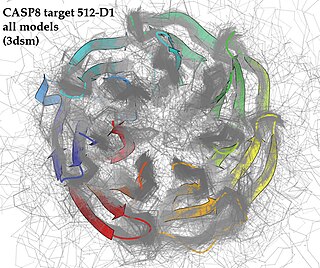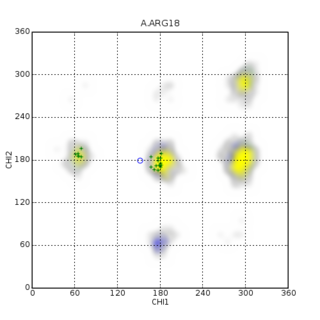Related Research Articles

Critical Assessment of Structure Prediction (CASP), sometimes called Critical Assessment of Protein Structure Prediction, is a community-wide, worldwide experiment for protein structure prediction taking place every two years since 1994. CASP provides research groups with an opportunity to objectively test their structure prediction methods and delivers an independent assessment of the state of the art in protein structure modeling to the research community and software users. Even though the primary goal of CASP is to help advance the methods of identifying protein three-dimensional structure from its amino acid sequence many view the experiment more as a “world championship” in this field of science. More than 100 research groups from all over the world participate in CASP on a regular basis and it is not uncommon for entire groups to suspend their other research for months while they focus on getting their servers ready for the experiment and on performing the detailed predictions.

Pfam is a database of protein families that includes their annotations and multiple sequence alignments generated using hidden Markov models. The most recent version, Pfam 36.0, was released in September 2023 and contains 20,795 families.
Expasy is an online bioinformatics resource operated by the SIB Swiss Institute of Bioinformatics. It is an extensible and integrative portal which provides access to over 160 databases and software tools and supports a range of life science and clinical research areas, from genomics, proteomics and structural biology, to evolution and phylogeny, systems biology and medical chemistry. The individual resources are hosted in a decentralized way by different groups of the SIB Swiss Institute of Bioinformatics and partner institutions.
Implicit solvation is a method to represent solvent as a continuous medium instead of individual “explicit” solvent molecules, most often used in molecular dynamics simulations and in other applications of molecular mechanics. The method is often applied to estimate free energy of solute-solvent interactions in structural and chemical processes, such as folding or conformational transitions of proteins, DNA, RNA, and polysaccharides, association of biological macromolecules with ligands, or transport of drugs across biological membranes.
Protein subfamily is a level of protein classification, based on their close evolutionary relationship. It is below the larger levels of protein superfamily and protein family.
This is a list of notable computer programs that are used for nucleic acids simulations.
SUPERFAMILY is a database and search platform of structural and functional annotation for all proteins and genomes. It classifies amino acid sequences into known structural domains, especially into SCOP superfamilies. Domains are functional, structural, and evolutionary units that form proteins. Domains of common Ancestry are grouped into superfamilies. The domains and domain superfamilies are defined and described in SCOP. Superfamilies are groups of proteins which have structural evidence to support a common evolutionary ancestor but may not have detectable sequence homology.

In biomolecular structure, CING stands for the Common Interface for NMR structure Generation and is known for structure and NMR data validation.
Biology Monte Carlo methods (BioMOCA) have been developed at the University of Illinois at Urbana-Champaign to simulate ion transport in an electrolyte environment through ion channels or nano-pores embedded in membranes. It is a 3-D particle-based Monte Carlo simulator for analyzing and studying the ion transport problem in ion channel systems or similar nanopores in wet/biological environments. The system simulated consists of a protein forming an ion channel (or an artificial nanopores like a Carbon Nano Tube, CNT), with a membrane (i.e. lipid bilayer) that separates two ion baths on either side. BioMOCA is based on two methodologies, namely the Boltzmann transport Monte Carlo (BTMC) and particle-particle-particle-mesh (P3M). The first one uses Monte Carlo method to solve the Boltzmann equation, while the later splits the electrostatic forces into short-range and long-range components.

WeNMR is a worldwide e-Infrastructure for NMR spectroscopy and structural biology. It is the largest virtual Organization in the life sciences and is supported by EGI.

In molecular biology, protein fold classes are broad categories of protein tertiary structure topology. They describe groups of proteins that share similar amino acid and secondary structure proportions. Each class contains multiple, independent protein superfamilies.
The ViennaRNA Package is a set of standalone programs and libraries used for prediction and analysis of RNA secondary structures. The source code for the package is distributed freely and compiled binaries are available for Linux, macOS and Windows platforms. The original paper has been cited over 2000 times.
Donna R. Maglott is a staff scientist at the National Center for Biotechnology Information known for her research on large-scale genomics projects, including the mouse genome and development of databases required for genomics research.
Teresa Lyn Head-Gordon is an American chemist and the Chancellor's Professor of Chemistry, Bioengineering, and Chemical and Biomolecular Engineering at the University of California, Berkeley. She is also a faculty scientist in the Chemical Sciences Division at the Lawrence Berkeley National Laboratory and a fellow of both the American Institute for Medical and Biological Engineering and the American Chemical Society (ACS).
David S. Wishart is a Canadian researcher and a Distinguished University Professor in the Department of Biological Sciences and the Department of Computing Science at the University of Alberta. Wishart also holds cross appointments in the Faculty of Pharmacy and Pharmaceutical Sciences and the Department of Laboratory Medicine and Pathology in the Faculty of Medicine and Dentistry. Additionally, Wishart holds a joint appointment in metabolomics at the Pacific Northwest National Laboratory in Richland, Washington. Wishart is well known for his pioneering contributions to the fields of protein NMR spectroscopy, bioinformatics, cheminformatics and metabolomics. In 2011, Wishart founded the Metabolomics Innovation Centre (TMIC), which is Canada's national metabolomics laboratory.
IntFOLD is fully automated, integrated pipeline for prediction of 3D structure and function from amino acid sequences. The pipeline is wrapped up and deployed as a Web Server. The core of the server method is quality assessment using built-in accuracy self-estimates (ASE) which improves performance prediction of 3D model using ModFOLD.
References
- ↑ Jurrus, Elizabeth; Engel, Dave; Star, Keith; Monson, Kyle; Brandi, Juan; Felberg, Lisa E.; Brookes, David H.; Wilson, Leighton; Chen, Jiahui (2017-08-24). "Improvements to the APBS biomolecular solvation software suite: Improvements to the APBS Software Suite". Protein Science. 27 (1): 112–128. doi:10.1002/pro.3280. PMC 5734301 . PMID 28836357.
- ↑ McCammon, J. Andrew; Holst, Michael J.; Joseph, Simpson; Sept, David; Baker, Nathan A. (2001-08-28). "Electrostatics of nanosystems: Application to microtubules and the ribosome". Proceedings of the National Academy of Sciences. 98 (18): 10037–10041. Bibcode:2001PNAS...9810037B. doi: 10.1073/pnas.181342398 . ISSN 0027-8424. PMC 56910 . PMID 11517324.
- ↑ Baker, Nathan A.; McCammon, J. Andrew; Nielsen, Jens E.; Dolinsky, Todd J. (2004-07-01). "PDB2PQR: an automated pipeline for the setup of Poisson–Boltzmann electrostatics calculations". Nucleic Acids Research. 32 (suppl_2): W665–W667. doi:10.1093/nar/gkh381. ISSN 0305-1048. PMC 441519 . PMID 15215472.
- ↑ Baker, Nathan A.; Klebe, Gerhard; Jensen, Jan H.; Nielsen, Jens E.; Li, Hui; Czodrowski, Paul; Dolinsky, Todd J. (2007-07-01). "PDB2PQR: expanding and upgrading automated preparation of biomolecular structures for molecular simulations". Nucleic Acids Research. 35 (suppl_2): W522–W525. doi:10.1093/nar/gkm276. ISSN 0305-1048. PMC 1933214 . PMID 17488841.
- ↑ "PQR molecular structure format — APBS-PDB2PQR 1.6 documentation". apbs-pdb2pqr.readthedocs.io. Retrieved 2019-05-23.